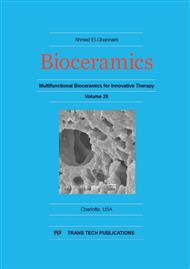p.37
p.41
p.46
p.53
p.58
p.65
p.69
p.77
p.82
An Intrinsic Angiogenesis Approach and Varying Bioceramic Scaffold Architecture Affect Blood Vessel Formation in Bone Tissue Engineering In Vivo
Abstract:
Early establishment of angiogenesis is critical for bone tissue engineering. Recently, a technique was introduced, which is based on the idea of using axial vascularization of the host tissues in engineered grafts, namely the “intrinsic angiogenesis chamber” technique, which utilizes an artery and a vein to construct an AV-Bundle. The aim of this study was to evaluate the effect of varying scaffold architecture of calcium alkali orthophosphate scaffolds (CAOP), resulting from two different fabrication procedures, namely 3D printing (RP) or a Schwarzwalder-Somers replica technique (SSM), on angiogenesis in vivo when combining a microvascular technique with bioceramic scaffolds colonized with stem cells for bone tissue engineering. 32 adult female Wistar rats, in which critical size segmental discontinuity defects 6 mm in length were created in the left femur, were divided into 4 groups, group 1 received a RP scaffold colonized with rat stem cells after 7d of dynamic cell culture and an AV-Bundle (AVB), group 2 a SSM scaffold with rat stem cells after 7d of dynamic cell culture and an AVB, group 3 a RP control scaffold (without cells and AVB), group 4 a SSM control scaffold (without cells and AVB). After 3 and 6 months, angiomicro-CT after perfusion with a contrast agent, image reconstruction, histomorphometric and immunohistochemical analysis utilizing antibodies to collagen IV, vWF and CD-31 were performed. At 6 months, a statistically significant higher blood vessel volume%, blood vessel surface/volume, blood vessel thickness, blood vessel density and blood vessel linear density was observed with RP scaffolds with cells and AVB than with the other groups. At 6 mths, RP with cells and AVB displayed the highest expression of collagen IV (score 2.75), CD31 (score 2.75) and vWF (score 2.6), which is indicative of highly dense blood vessels. Both angio-CT and immunohistochemical analysis demonstrated that AVB is an efficient technique for achieving scaffold vascularization in critical size segmental defects after 3 and 6 months of implantation.
Info:
Periodical:
Pages:
58-64
Citation:
Online since:
November 2016
Price:
Сopyright:
© 2017 Trans Tech Publications Ltd. All Rights Reserved
Share:
Citation:


